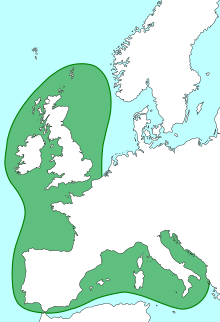Epimeria frankei
| Epimeria frankei | ||||||||||||
|---|---|---|---|---|---|---|---|---|---|---|---|---|

Epimeria frankei , drawing from 1850 |
||||||||||||
| Systematics | ||||||||||||
|
||||||||||||
| Scientific name | ||||||||||||
| Epimeria frankei | ||||||||||||
| Beermann & Raupach , 2018 |
Epimeria frankei is a kind of flea crabs from the genus Epimeria . The approximately 2 cm long, brownish amphipods inhabit the shallow to deep sea zones of the Mediterranean and the eastern Atlantic to the southern North Sea . Like other species of the genus, they may beassociatedwith deep - sea corals , hydrozoans and sea cucumbers on the sea floor; Little is known about their ecology, however.
For a long time Epimeria frankei was placed in a common species with Epimeria cornigera , the distribution of which reached from the arctic regions of the Atlantic to the Mediterranean. Molecular biological investigations, however, revealed a clear genetic divergence, which speaks in favor of distinguishing between a southern and a northern species.
features
Epimeria frankei becomes about 19 mm long, with females on average being larger than males. The animals are uniformly gray-brown in color, which distinguishes them from the closely related E. cornigera , which has red and white stripes. The peraeon plates of the thorax show a dorsal tooth process on the sixth and seventh, rarely also on the fifth peraeonite . The Coxalplatten access as with all Epimeria TYPES into each other, which probably serves the animals in rolled-up state for defense against predators. The third Urosomit has a vertical extension which against E- cornigera is diagnostic. The red eyes of the species are large, round, and clearly protruding from the head.
Distribution and ecology

Epimeria frankei could be assigned to various historical and current finds on the basis of morphological descriptions and molecular genetic analyzes, which extend from the Ligurian Sea to the north coast of Scotland and were originally identified as E. cornigera . In the case of some finds in the past, however, due to incomplete information, there is no final certainty about the species belonging, so that, for example, finds from the Adriatic Sea could only be determined due to the large gap in the distribution of the next reliable E. cornigera records in the North Sea .
The presumed distribution area of Epimeria frankei stretches from the Adriatic around the Italian Peninsula into the Tyrrhenian and Ligurian Sea to Gibraltar . From there it probably follows the Iberian coastal region and includes the Bay of Biscay and the British Isles in the north . North-east of Scotland , the species was detected just off the Norwegian coast. In the region around the Scottish coast, the species occurs sympatric with E. cornigera .
As with most species of the genus, little is known about the ecology of animals. It is believed that it mainly inhabits the sea floor and is associated there with corals , hydrozoans and sea cucumbers .
Systematics and taxonomy
|
||||||||||||||||||||||||||||||||||||||||||||||||||||||||||||||||||||||||||||||||||||||||||||||||
| Systematics of the genus Epimeria (simplified) according to Beermann et al. (2018). Epimeria frankei and E. cornigera are sister species that are relatively basal in the genus' family tree. |
Over the past 350 years Epimeria frankei was placed in a broad species Epimeria cornigera , which included both brown and reddish individuals and whose distribution reached from the Adriatic to Arctic waters. In 2013, various Epimeria specimens were caught west of Bergen and examined for the CO1 sequence of their mtDNA . The analysis showed a divergence of 8.69–11.81% of the base pairs, which is in the range of the average differences between other species of the genus. Together with consistent color and anatomical differences, a group of researchers led by marine biologist Jan Beermann to separate the southern population into a separate species Epimeria frankei Beermann & Raupach , 2018 . As an epithet for the new species, Beermann chose frankei in honor of his long-time mentor Heinz-Dieter Franke .
Epimeria frankei is a sister species of the closely related E. cornigera , with which it shares its habitat in the North Sea, relatively basal in the genus Epimeria . The sister clade of the two species are E. bruuni and E. horstii ; together, all four species oppose the rest of the genus.
References
literature
- Jan Beermann, Michael V. Westbury, Michael Hofreiter, Leon Hilgers, Fabian Deister, Hermann Neumann, Michael J. Raupach: Cryptic species in a well-known habitat: applying taxonomics to the amphipod genus Epimeria (Crustacea, Peracarida) . In: Scientific Reports . tape 8 , no. 1 , 2018, doi : 10.1038 / s41598-018-25225-x .